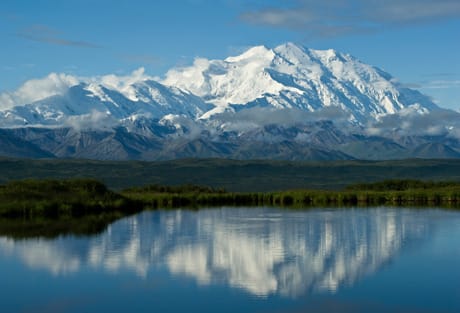Alaska: A Quick Guide for Cruisers
A quick-guide for the sites and activities of Alaska and its seaports.
Products are chosen independently by our editors. Purchases made through our links may earn us a commission.
Cruising Alaska (official travel site) reveals a world of wild beauty: the sparkling sea in the midnight sun, blue-white glaciers, green forests and snowy mountains. Seabirds, falcons and eagles soar overhead and whales, dolphins and sea lions break the water’s surface. Small fishing towns whose history stretches back to the era of Russian fur traders and gold seekers dot the coastline.

The state’s southernmost city, Ketchikan, is Alaska’s wettest place. Downtown, the “Liquid Sunshine Gauge” graphically shows the city’s 162-inch average rainfall – in feet. Ketchikan also is the salmon capital of the world and thousands of the silver leapers may be seen from Creek Street in the old “red light” district. Native tribes retain a strong presence and elaborately carved totem poles can be viewed at Saxman Native Village, Totem Bight State Park, Totem Heritage Center and even in front of residences.
Alaska’s capital, Juneau, is a mix of frontier flavor, still alive at the Red Dog Saloon, and urban culture in its symphony and theatres. The Alaska State Museum features displays on native tribes and the Gold Rush and Russian colonial eras. Within the city limits is the stunning Mendenhall Glacier. For a panoramic view the Mount Roberts tramway carries visitors 2,000 feet above Juneau in six minutes.
North of Juneau is Haines, known for the Chilkat Bald Eagle Preserve which protects the world’s largest concentration of bald eagles. The town, founded by Presbyterian missionaries in 1879, is linked to Alaska’s vast interior by the Haines Highway.
Klondike prospectors began their 500-mile journey to Alaska’s gold fields in Skagway. The White Pass and Yukon Railroad, built in 1898, eased their burden; today it offers spectacular views and an appreciation of their arduous trek. Skagway’s past comes alive in Old Town and Days of ’98 show, featuring a re-enactment of a Klondike-era shootout, culminating in the death of notorious “Soapy” Smith.
Sitka, the former capital of Russian America - an “occupation” that extended almost to San Francisco - shows its heritage in the onion-domed St Michael’s Cathedral and Bishop’s House. Totem poles and exhibits about the local Tlingit and Haida tribes are displayed at the scenic 113-acre National Historical Park.
Seward, the main cruise ship port for Anchorage, lies just outside the glorious Kenai Fjords where visitors see up close how glaciers reshape the landscape. The town is named for Lincoln’s election rival and later Interior Secretary, William Seward, the man who purchased Alaska from Russia for $7.2 million – two cents an acre.
Another port is Whittier, 60 miles south of Anchorage on mountain-ringed Prince William Sound. Glacier tours and salmon fishing are popular activities. Grizzlies and black bears are among the rescued and orphaned animals that can be seen at the Wildlife Conservation Center.
Anchorage, with major airport and connections to Seward and Whittier, serves as the first or final port of call for most cruise passengers. Alaska’s most populous city is a modern metropolis but wilderness is at its back door with 300 miles of hiking and biking trails and a large collection of glaciers nearby. Overnight excursions to Denali National Park are a top draw for visitors eager to catch a glimpse of towering Mount McKinley, the tallest peak in North America.
